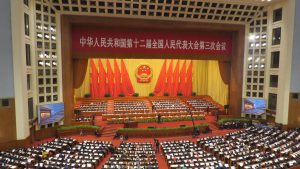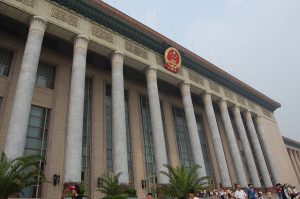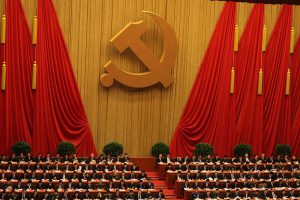Editor’s note
The Chinese People’s Political Consultative Conference (CPPCC) a body that submits policy proposals to the Chinese government, has gathered its 2,000 members in Beijing for its annual conference to discuss China’s politics, economy, culture and society. The advisory body also makes its own suggestions and members can also submit their own motions on matters they are particularly concerned about. There is no guarantee any such proposal will be adopted by the government, but all submissions receive a response. One particular suggestion catches the eye. CPPCC member and former head of the Ministry of Finance’s Institute of Fiscal Science, Jia Kang, has previously written a draft law on an environmental tax that he hopes will be a major lever to implement the various environment-related policies to be included in China’s 13th Five-Year Plan, further details of which will emerge this week. Below, he gives his response to a different version of the draft law, which has been circulating at this month’s twin sessions in Beijing.

Jia Kang: In recent years, China has adopted a range of policies designed to improve the environment and cut the consumption of fossil fuels and emission of greenhouse gases, with some success. However, significant issues remain: resource and environmental crises are still apparent, such as the smog problem; and it is clear that traditional administrative interventions alone are inadequate to deal with the issues currently prominent, and would have negative impacts on the market economy and on certain populations, which cannot be ignored. A better and more comprehensive policy is needed, including the application of economic levers, such as taxation.
Green tax reform, such as introducing an environmental protection tax and “greening the tax system”, is essential if we are to accelerate the change in our mode of economic growth and seek sustainable development. It will also reduce pollution and improve livelihoods. China currently has no specific environmental taxes, and current charges made for the release of pollutants are low and too narrowly applied – there is no systematic approach to environmental taxation. This is to some extent why environmental protection has not seen any obvious benefits.
The 5th Plenum of the 19th Party Congress stated that China is to build a modern financial and taxation system, and develop in accordance with its environmental and resource capacities. A system of legislation for environmental taxation would be a key strategy for China’s construction of an ecological civilisation and achieving sustainable, green and low-carbon development. The decisions of the 5th Plenum and the Overall Plan for Ecological Civilisation Reform both called explicitly for “faster reform of taxation of resource and environmental taxes”, including, “faster legislation for an environmental protection tax.”
In June 2015, and after years of debate and preparation, the Legislative Affairs Office of the State Council published a consultation draft of an Environmental Protection Tax Law. The draft lays a solid foundation for defining the tax and ensuring it is applied in a standardised and transparent manner, which will help rally support. But the draft as it stands is overly conservative and retains too much of the approach behind the existing fees charged for pollution, with not enough done to reform those charges into a tax. For various reasons, we do not have an environmental tax reform to implement and improve as part of the 13th Five-Year Plan.
To bring about an environmental protection tax that can more effectively and flexibly contribute to saving energy and reducing emissions and bring the design of an environmental tax into line with other tax reforms and policy tools, the following proposals are made:
-
Bring the environmental protection tax into line with ongoing taxation reforms. The environmental tax should not add to the overall tax burden. The new environmental protection tax and the reformed resources tax should be accompanied by reductions in other economic taxes such as business and personal income taxes and customs tariffs. Also, all income from the environmental protection tax should go to local government for general expenditure, rather than being ring fenced as it is currently (meaning pollution fees can only be used for environmental protection). As pollution fees are currently used to pay salaries for local environmental protection officials, local environmental protection bureaus should receive larger budgets and more resources, to bolster environmental protection at this level. Meanwhile the environmental authorities could include mid and long-term financing needs in their budget; and maintain a database of environmental protection projects to be used during budgeting decisions.
-
Increase environmental protection tax rates and widen the scope of collection. Being too conservative will simply repeat the mistakes made with the pollution fees and not spur companies to cut emissions. The higher pollution fees applied in some cities can be referred to: Beijing has increased the average fee to 10 yuan for each kilogramme of sulphur dioxide, nitrogen oxides and chemical oxygen demand. This is far above the proposed level of taxation in the consultation draft (1.26, 1.26 and 1.4 yuan respectively). Estimates put the cost of scrubbing sulphur at a Chinese power plant at between 2 and 5 yuan per kilogramme – much more than the 1.26 yuan cost of releasing that sulphur would be. If taxation is not increased the effects will be much reduced. It is also proposed that exemptions are removed for small scale farms and urban waste water treatment plants and waste disposal facilities which meet standards. In 2013, urban waste water accounted for almost 70% of China’s waste water emissions; between 2014 and 2020 it is expected that China’s cities will produce an extra 31.62 million tonnes of waste; in 2014, agriculture accounted for 48% of chemical oxygen demand emissions and 32% of ammonia emissions. In both absolute and relative terms these sources of pollution are highly significant, and rules exempting these from taxation should be ended.
-
Establish a clear division of labour across departments. It is proposed that the environmental authorities’ existing data of reported and audited pollution emissions be used as the basis for setting amounts of tax to be paid. As the environmental authorities are the main environmental regulators, collection of pollution data is a major part of their work. Making full use of this data will prevent that work being repeated and unnecessarily adding to the burden on both government and businesses. Businesses will report their emissions to the environmental authorities, which will check the data. The company will then report tax to be paid to the taxation authorities, which will collect it. Information will also be shared across all departments.
- Use openness of environmental information to increase collection of the environmental tax. The new revision of the Environmental Protection Law legislates that data on pollution by businesses shall be made public, to allow for public supervision. The environmental protection tax is based on that pollution data, and a publicly available tax calculation method. It is therefore legally justified and practically feasible to make the amount of environmental tax paid by a business public, and The Environmental Protection Tax Law should make clear that tax offices must do so. This should be done in detail and systematically, including at least quarterly business pollution data, the technical details of how that data was collected, the tax rates applied, any reductions applied, and what has actually been paid. This can be done jointly between the tax and environmental authorities. The establishment of an environmental protection tax database is proposed, to allow the public to consult taxation and pollution data for specific companies.







